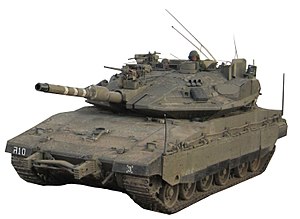| Merkava | |
|---|---|
 Merkava Mk 4M Windbreaker, equipped with the Trophy active protection system, during Operation Protective Edge 2014. | |
| Type | Main battle tank |
| Place of origin | Israel |
| Service history | |
| In service | 1979–present[1] |
| Used by | See Operators |
| Wars | |
| Production history | |
| Designer | Mantak |
| Manufacturer | Mantak, IDF Ordnance Corps (assembly) |
| Unit cost | |
| Produced | 1979–present |
| No. built |
|
| Specifications | |
| Mass | 65 tonnes (143000 pounds) |
| Length |
|
| Width | 3.72 m or 12.2 ft (excl. skirts) |
| Height | 2.66 m or 8.7 ft (to turret roof) |
| Crew | 4 (commander, driver, gunner, and loader) |
| Armor | Classified composite/sloped armour modular design. |
Main armament | 120 mm (4.7 in) MG251-LR smoothbore gun, capable of firing LAHAT ATGM |
Secondary armament |
|
| Engine | MTU 12V883 1119 kW (1501 hp) turbocharged diesel engine (4, 5) |
| Power/weight | 18.8 kW/t |
| Payload capacity | 48 rounds |
| Transmission | Renk RK 325 |
| Suspension | Helical spring |
| Ground clearance | 0.45 m (1.5 ft) |
| Fuel capacity | 1400 litres |
Operational range | 500 km (310 mi) |
| Maximum speed |
|
The Merkava (Hebrew: מֶרְכָּבָה, [mɛʁkaˈva] , "chariot")[5] is a series of main battle tanks used by the Israel Defense Forces (IDF) and the backbone of the IDF's Armored Corps. Current iterations of this tank are considered broadly equivalent to the capabilities of the M1 Abrams, Leopard 2 and the Challenger 2.[6][7][8] The current iteration of this vehicle also shares the same MTU EuroPowerPack powerplant as a number of other tank platforms.[9]
Development began in 1970,[10] and its first generation, the Merkava Mark 1, entered official service in 1979.[11] Four main variants have been deployed. As of 2023, Merkava Mark 4 Barak[12] is the latest version. The Merkava was first used extensively in the 1982 Lebanon War. The name "Merkava" was derived from the IDF's initial development program name.
The tank was developed in the Merkava and Armored Combat Vehicles Division of the Israeli Ministry of Defense, and most of its parts are manufactured in Israel. The Merkava was designed to provide maximum protection for its crew, and therefore its front armor was fortified and the engine placed in the front part of the tank, unlike most other tanks.
Design criteria include rapid repair of battle damage, survivability, cost-effectiveness, and off-road performance. Following the model of contemporary self-propelled howitzers, the turret assembly is located closer to the rear than in most main battle tanks. With the engine in front, this layout is intended to provide additional protection against a frontal attack, so as to absorb some of the force of incoming shells and projectiles,[13] especially for the personnel in the main hull, such as the driver. It also creates more space in the rear of the tank that allows increased storage capacity and a rear entrance to the main crew compartment allowing easy access under enemy fire. This allows the tank to be used as a platform for medical disembarkation (with no ammunition, the Merkava can hold up to 4 stretchers, but this is only an emergency measure), a forward command and control station, and an infantry fighting vehicle. The rear entrance's clamshell-style doors provide overhead protection when off- and on-loading cargo and personnel.
- ^ "Merkava". Tanks. Israeli weapons.
- ^ "Merkava Lite?". TheMarker. October 17, 2003. Archived from the original on April 17, 2017. Retrieved March 14, 2018 – via Haaretz.
- ^ "Singapore looks out for Israeli defence interests". June 8, 2014.
- ^ Israel (PDF). Studies (Report). The Institute for National Security. November 20, 2014. Archived from the original (PDF) on November 24, 2015.
- ^ "Israel plans first sale of Merkava tank to European country". Reuters. June 15, 2023. Retrieved August 4, 2023.
- ^ "Merkava Tanks: Are they world leading? - Technology Org". March 3, 2023. Retrieved November 2, 2023.
- ^ Mizokami, Kyle (November 18, 2020). "How Good is the Merkava Tank? (Pretty Good, It Turns Out)". The National Interest. Retrieved November 2, 2023.
- ^ Axe, David. "Israel's Merkava Mark IV Tanks Are More Drone-Proof Than Other Tanks". Forbes. Retrieved November 2, 2023.
- ^ "First 1650 Horsepower EuroPowerPack delivered". www.mtu-solutions.com. Retrieved November 5, 2023.
- ^ Maoz, Zeev (2006). "5". Defending the Holy Land. University of Michigan Press. note 16. ISBN 0-47211540-5.
- ^ "טנקי המרכבה לדורותיהם" [Chariot tanks for generations]. Ministry of Defense, Israel (in Hebrew). Retrieved October 20, 2021.
- ^ "Merkava 4 MBT to commence series production". www.defenceprocurementinternational.com. Retrieved November 3, 2023.
- ^ Roblin, Sebastien (December 31, 2016). "America's M1 Abrams Tank vs. Israel's Merkava: Who Wins?". The National Interest. Archived from the original on December 1, 2017. Retrieved March 14, 2018.